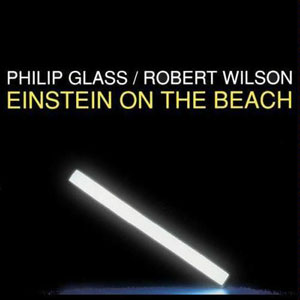 Robert Wilson, Philip Glass’ collaborator on Einstein on the Beach, noted that until that work hit the boards, theater was bound by literature. Thinking on it, he’s pretty much right: stage plays, opera, even film were constrained by a narrative line that relied on a chronological sequence, all based on language. Not so Einstein.
Robert Wilson, Philip Glass’ collaborator on Einstein on the Beach, noted that until that work hit the boards, theater was bound by literature. Thinking on it, he’s pretty much right: stage plays, opera, even film were constrained by a narrative line that relied on a chronological sequence, all based on language. Not so Einstein.
In keeping with the conceptual thrust of Glass’ three “portrait” operas (Einstein on the Beach, Satyagraha, and Akhnaten), Einstein himself is portrayed as a historical icon, with no story line attached. In terms of theater, we’re experiencing a true collaboration: the action, music, scenery and lighting were all created as parts of a unified idea. (It’s symptomatic of the organic nature of this work that a “new” production was attempted in 1989 at the Stuttgart State Opera, which was pretty much a adjudged a failure, although revivals of the original production meet with ready welcome.) Wilson’s visual elements can stand alone, as can Glass’ music, but together they seem to create more than one would believe possible. Add a “libretto” composed mostly of numbers and solfége syllables (do, re, mi, etc.), which doesn’t lend itselve very well to a traditional linear narrative structure — or perhaps it’s more accurate to say that such structures become irrelevant — interspersed with the poetry of Christopher Knowles and short texts by Lucinda Childs and Samuel Johnson — and you’ve pretty much exploded the boundaries of traditional theater.
Glass’ music, itself, doesn’t really lend itself to a linear narrative. It’s not particularly linear music — at least it wasn’t in 1976, when the opera was written. One wants it to be linear — that momentum should be going someplace, right? It does, but it doubles back on itself, a function of Glass’ basic compositional technique of repetitive motifs, modulated in tiny increments. The instrumental ensemble is composed of five members (there are actually more, but never more that five playing at once), and the chorus does a lot of the work: it’s really the chorus that creates the texture, while the instrumentalists provide the momentum — and, now that I’ve written that, it’s a gross oversimplification: the musical fabric is much too rich and complex to be summarized so neatly.
The opera is a collage as much as anything else, musical phrases repeated, the repetitions circling back to create new images from the same components, the chorus and soloists and spoken passages adding yet more imagery. In production, it runs around five hours; Glass encouraged the audience to take breaks as needed, since there are no intermissions between acts, and there’s no story to miss. This recording, the second made, runs not quite three and a half hours. Glass, quoted in Tim Page’s essay included with this set, definitely assigns this recording pride of place: the additional length (30 minutes) adds to the experience, and, as he notes, “we just play the music so much more skillfully today than we could back in the 1970s.”
As it stands, this really is a landmark recording of an important twentieth-century work, although Einstein‘s influence on subsequent works is moot: it was, as Page points out, by design a “one shot” — “a work that invented its context, form and language, and then explored them so exhaustively that further development would have been redundant.”
There’s not much to say after that.
Personnel: The Philip Glass Ensemble, Michael Riesman, cond.; chorus; Patricia Schuman, soprano; Lucinda Childs, Gregory Dolbashian, Jasper McGruder, Sheryl Sutton, speakers.
(Nonesuch Records/Elektra Entertainment [Warner Communications], 1993)
